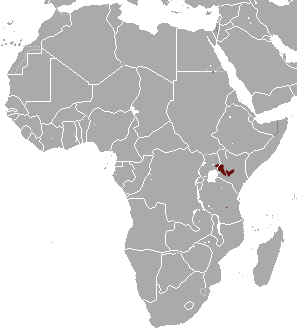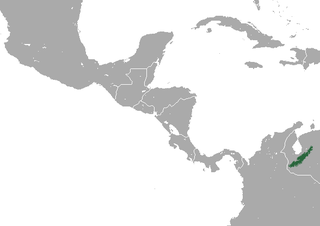
Aardvarks are medium-sized, burrowing, nocturnal mammals native to Africa. Aardvarks are the only living species of the family Orycteropodidae and the order Tubulidentata. They have a long snout, similar to that of a pig, which is used to sniff out food.

Elephant shrews, also called jumping shrews or sengis, are small insectivorous mammals native to Africa, belonging to the family Macroscelididae, in the order Macroscelidea. Their traditional common English name "elephant shrew" comes from a perceived resemblance between their long noses and the trunk of an elephant, and their superficial similarity with shrews in the order Eulipotyphla. However, phylogenetic analysis has revealed that elephant shrews are not properly classified with true shrews, but are in fact more closely related to elephants than to shrews. In 1997, the biologist Jonathan Kingdon proposed that they instead be called "sengis", a term derived from the Bantu languages of Africa, and in 1998, they were classified into the new clade Afrotheria.

The golden-rumped sengi is a small African mammal. It is the largest species of the elephant shrew family along with its close relative the grey-faced sengi. It is classified as endangered.

The marsh shrew, also known as the Pacific water shrew, Bendire's water shrew, Bendire's shrew and Jesus shrew is the largest North American member of the genus Sorex. Primarily covered in dark-brown fur, it is found near aquatic habitats along the Pacific coast from southern British Columbia to northern California. With air trapped in its fur for buoyancy, marsh shrews can run for three to five seconds on top of the water. It measures about 16 cm (6.3 in) in length, including a 7-centimetre (2.8 in)-long tail, and weighs an average of 14.5–16 g (0.51–0.56 oz). The marsh shrew's diet consists mainly of invertebrates, which it hunts on land and in the water. They are rare; their populations are thought to be in decline, and they are considered endangered in parts of their range.

The southern short-tailed shrew is a gray, short-tailed shrew that inhabits the eastern United States.

The giant otter shrew is a semiaquatic, carnivorous afrotherian mammal. It is found in the main rainforest block of central Africa from Nigeria to Zambia, with a few isolated populations in Kenya and Uganda. It lives in streams, wetlands and slow flowing larger rivers. It is the only species in the genus Potamogale. Otter shrews are most closely related to the tenrecs of Madagascar.

Jackson's mongoose is a mongoose species native to montane forests in Kenya, Uganda and Tanzania. It appears to be rare and has been classified as Near Threatened since 2008.

The black and rufous sengi, the black and rufous elephant shrew, or the Zanj elephant shrew is one of the 17 species of elephant shrew found only in Africa. It is native to the lowland montane and dense forests of Kenya and Tanzania. Like other members of the genus Rhynchocyon, it is a relatively large species, with adults averaging about 28 cm (11 in) in length and 450–700 g (16–25 oz) in weight.

Amblysomus is a genus of the golden mole family, Chrysochloridae, comprising five species of the small, insect-eating, burrowing mammals endemic to Southern Africa. All five species can be found in South Africa and some are also found in Eswatini and Lesotho.

The short-snouted elephant shrew or short-snouted sengi is a species of elephant shrew in the family Macroscelididae. It is found over a wide area of Africa. Its natural habitats are dry savanna and subtropical or tropical dry lowland grassland.

The North African elephant shrew or North African sengi is a species of elephant shrew in the family Macroscelididae. It is found in Algeria, Libya, Morocco, and Tunisia, and is the only extant afrotherian within its range. The species was formerly classified in the genus Elephantulus, but molecular evidence indicates that it is more closely related to Petrodromus than to other members of Elephantulus. It was moved to a new genus, Petrosaltator, in 2016. The split with Petrodromus likely occurred during the Miocene period.

The chequered sengi is a species of elephant shrew in the family Macroscelididae. The scientific name is Rhynchocyon cirnei.

Rhynchocyon is a genus of elephant shrew in the family Macroscelididae. Members of this genus are known colloquially as giant sengis. They are a ground-dwelling mammal, significantly larger than their relatives in the order Macroscelidea that live primarily in dense forests across eastern Africa. Habitats range from eastern Africa's coastal forests, Rift Valley highlands, and the Congo basin. The species is widely threatened, with two of four assessed by the International Union for Conservation of Nature's Red List of Threatened Species. Habitat fragmentation from the growth of human settlements and activities are the primary threats to their populations. The genus contains the following five species and several subspecies:

The African giant shrew is a species of white-toothed shrew. It also is known as, Mann's musk shrew, Euchareena's musk shrew, or Olivier's shrew. It is native to Africa, where it has a widespread distribution and occurs in many types of habitat. Its natural habitats are subtropical or tropical dry forest, subtropical or tropical moist lowland forest, subtropical or tropical moist montane forest, dry savanna, moist savanna, arable land, rural gardens, urban areas, and heavily degraded former forest. In the Nile Valley it is found near human habitation, where it is considered to be a pest. It is a common species and is listed by the International Union for Conservation of Nature as being of "least concern".

The Merida small-eared shrew is a species of shrew that is endemic to Venezuela.

The forest shrew is a species of shrew in the mouse shrew family, Soricidae. It is found in Lesotho, South Africa, and Eswatini. Its natural habitats include temperate forests, dry savanna, Mediterranean-type shrubby vegetation, and temperate grassland. The term "forest shrews" in the plural is sometimes confusingly used to collectively refer to a different genus, Sylvisorex.

The northern tamandua is a species of tamandua, an anteater in the family Myrmecophagidae. They live in tropical and subtropical forests from southern Mexico, through Central America, and to the edge of the northern Andes.

The southeastern shrew is a species of mammal in the family Soricidae. It is found in the southeastern United States.

Sanford's brown lemur, or Sanford's lemur, is a species of strepsirrhine primate in the family Lemuridae. Sanford's brown lemur was previously considered a subspecies of the common brown lemur but was raised to full species in 2001. It is named after Leonard Cutler Sanford, a trustee of the American Museum of Natural History.





















